by B. Lomborg, Feb 6, 2022 in Daily Mail
-
While diesel cars tend to be more fuel-efficient with lower emissions, they also emit greater quantities of other pollutants that damage air quality and health
-
Now, electric cars could be the future for many as BJORN LOMBORG explains
Do you remember Britain’s ‘dash for diesel’? It began more than 20 years ago when the then Chancellor, Gordon Brown, announced a new car tax system favouring vehicles with lower emissions of carbon dioxide, the greenhouse gas that contributes to global warming.
Diesel cars tend to be more fuel-efficient with lower emissions, and Mr Brown hailed them as the greener and cheaper option. Over a decade and a half, the number of such vehicles on British roads quadrupled.
What didn’t emerge until much later — although it was no secret in the motor industry or among government officials — was that diesel cars also emitted greater quantities of other pollutants, nitrogen oxides and particulates that damage air quality and human health.
…
by P. Homewood, Jan 6, 2021 in NotaLotofPeopleKnowThat
When Donald Trump offered to buy Greenland from Denmark in 2019 it was dismissed as illegal and absurd. However, the president’s expression of interest was far from absurd, says Guillaume Pitron. Under its soil Greenland boasts one of the largest concentrations of the rare metals that the world will need to power electric cars, computers, mobile phones, robots, solar power plants, artificial intelligence and many high-tech “green” innovations that have not been dreamt up yet. If Trump were after those minerals, buying Greenland would have been a smart move.
The global production and sales of rare metals are dominated by China. It mines so much of them on home soil and controls so much of their extraction in Africa and elsewhere that it oversees up to 95 per cent of the global production of certain minerals. This puts Beijing in charge of “the oil of the 21st century”, writes Pitron, which is a problem for western nations because it means China can restrict supply and drive prices up or down at will, as Opec does with oil. We have “entrusted a precious monopoly of mineral sovereignty to potential rivals”, he notes.
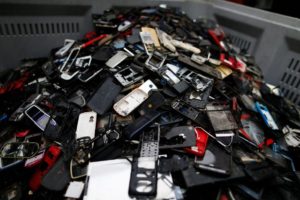
Discarded devices waiting to have their precious metals extracted
CHARLY TRIBALLEAU/GETTY IMAGES
Rare earth minerals production is very energy intensive. Extracting a single kilogram of some requires mining as much as 1,200 tonnes of rock. “Clean energy is a dirty affair,” Pitron writes. He drives home his point by touring villages near polluted lakes in China that are known locally as “cancer villages”.
…
by E. Quinn, Oct 26, 2020 in EyeOn Arctic
Microplastics have been identified in Antarctic waters at rates that mirror the amounts found in oceans elsewhere in the world, including the North Atlantic, says a new study.
“Although no difference in microplastic abundance was found among regions, the values were much higher in comparison to less remote ecosystems, suggesting that the Antarctic and Southern Ocean deep-sea accumulates higher numbers of microplastic pollution than previously expected,” said the authors in the abstract of the paper “High Abundances of Microplastic Pollution in Deep-Sea Sediments: Evidence from Antarctica and the Southern Ocean,” published Friday in the the journal Environmental Science & Technology.
Waters in three areas around Antarctica were sampled for the study: the Antarctic Peninsula, South Sandwich Islands, and South Georgia.
Levels “surprising”
Microplastic is the term used to describe plastics less than, or equal to 5mm.
The study found that just over one particle of microplastic was found in each gram of sediment in each of the three areas. This rate of microplastics mirrors the amounts found in other oceans that are considerably closer to human settlements.
“Our research highlights that no matter how remote an ecosystem is, it will still show the artefacts of human influence,” said Mánus Cunningham, a researcher from Queen’s University in Belfast, in a news release.
“We have been dumping plastic into our oceans for roughly 70 years now, so in hindsight this may not be terribly surprising. What is surprising is that the levels of this type of pollution are comparable to what we consider moderately or highly polluted regions of the world’s oceans.”
…
by D. Flanakin, Sep 19, 2020 in WUWT
They also heat the planet, blanket wildlife habitats and cause other ecological damage
The problem of solar panel waste is now becoming evident. As environmental journalist Emily Folk admits in Renewable Energy Magazine, “when talking about renewable energy, the topic of waste does not often appear.” She attributes this to the supposed “pressures of climate change” and alleged “urgency to find alternative energy sources,” saying people may thus be hesitant to discuss “possible negative impacts of renewable energy.”
Ms. Folk admits that sustainability requires proper e-waste management. Yet she laments, “Solar presents a particular problem. There is growing evidence that broken panels release toxic pollutants … [and] increasing concern regarding what happens with these materials when they are no longer viable, especially since they are difficult to recycle.”
This is the likely reason that (except in Washington state), there are no U.S. mandates for solar recycling. A recent article in Grist reports that most used solar panels are shipped to developing countries that have little electricity and weak environmental protections, to be reused or landfilled.
The near-total absence of end-of-life procedures for solar panels is likely a byproduct of the belief (and repeated, unsupported assertion) that renewable energy is “clean” and “green.” Indeed, Mississippi Sierra Club state director Louie Miller recently claimed that unlike fossil fuels and nuclear energy, “Sunshine is a free fuel.” Well, sunshine is certainly free and clean. However, there is a monumental caveat.
Harnessing sunshine (and wind) to serve humanity is not free – or clean, green, renewable or sustainable.
…
…
by O. Rudgard, September 3, 2020 in ClimateChaneDispatch
Mining for renewable energy materials could threaten biodiversity, researchers have found.
Scientists at the University of Queensland, Brisbane found a high degree of overlap between areas used for mining essential minerals like lithium, which is used for car batteries, and areas with high levels of biodiversity as yet untouched by industry.
Conservationists are “often naive to the threats posed by significant growth in renewable energies”, the researchers said in the study published in the journal Nature Communications, pointing out that 14 percent of protected areas contain metal mines or have them nearby.
Overall, the researchers found that eight percent of mining areas were within the range of areas designated as protected by national governments, and seven percent were within the same range of key biodiversity areas.
Using this metric, 50 million square kilometers of the earth’s land surface is influenced by mining, with 82 percent of mining areas focused on elements needed for renewable energy production.
Elements including lithium, cobalt, and nickel are essential for rechargeable batteries, which are used for power storage in wind and solar projects, as well as in electric cars.
New mines are planned to target these substances, adding to the global surface area covered by mining activities.
…
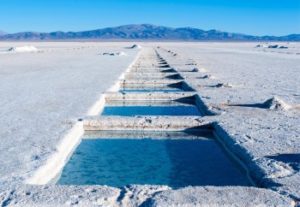
by Li, F. et al. July 31, 2020 in Front. Earth.Sci.
As a toxic and harmful global pollutant, mercury enters the environment through natural sources, and human activities. Based on large numbers of previous studies, this paper summarized the characteristics of mercury deposition and the impacts of climate change and human activities on mercury deposition from a global perspective. The results indicated that global mercury deposition changed synchronously, with more accumulation during the glacial period and less accumulation during the interglacial period. Mercury deposition fluctuated greatly during the Early Holocene but was stable and low during the Mid-Holocene. During the Late Holocene, mercury deposition reached the highest value. An increase in precipitation promotes a rise in forest litterfall Hg deposition. Nevertheless, there is a paucity of research on the mechanisms of mercury deposition affected by long-term humidity changes. Mercury accumulation was relatively low before the Industrial Revolution ca. 1840, while after industrialization, intensive industrial activities produced large amounts of anthropogenic mercury emissions and the accumulation increased rapidly. Since the 1970s, the center of global mercury production has gradually shifted from Europe and North America to Asia. On the scale of hundreds of thousands of years, mercury accumulation was greater in cold periods and less in warm periods, reflecting exogenous dust inputs. On millennial timescales, the correspondence between mercury deposition and temperature is less significant, as the former is more closely related to volcanic eruption and human activities. However, there remains significant uncertainties such as non-uniform distribution of research sites, lack of mercury deposition reconstruction with a long timescale and sub-century resolution, and the unclear relationship between precipitation change and mercury accumulation.
…
by University of Washington, March 24, 2020 in ScienceDaily
A container ship leaves a trail of white clouds in its wake that can linger in the air for hours. This puffy line is not just exhaust from the engine, but a change in the clouds that’s caused by small airborne particles of pollution.
New research led by the University of Washington is the first to measure this phenomenon’s effect over years and at a regional scale. Satellite data over a shipping lane in the south Atlantic show that the ships modify clouds to block an additional 2 Watts of solar energy, on average, from reaching each square meter of ocean surface near the shipping lane.
The result implies that globally, cloud changes caused by particles from all forms of industrial pollution block 1 Watt of solar energy per square meter of Earth’s surface, masking almost a third of the present-day warming from greenhouse gases. The open-access study was published March 24 in AGU Advances, a journal of the American Geophysical Union.
…
by The Guardian, August 13, 2019
Plastic was the furthest thing from Gregory Wetherbee’s mind when he began analyzing rainwater samples collected from the Rocky Mountains. “I guess I expected to see mostly soil and mineral particles,” said the US Geological Survey researcher. Instead, he found multicolored microscopic plastic fibers.
The discovery, published in a recent study (pdf) titled “It is raining plastic”, raises new questions about the amount of plastic waste permeating the air, water, and soil virtually everywhere on Earth.
“I think the most important result that we can share with the American public is that there’s more plastic out there than meets the eye,” said Wetherbee. “It’s in the rain, it’s in the snow. It’s a part of our environment now.”
Rainwater samples collected across Colorado and analyzed under a microscope contained a rainbow of plastic fibers, as well as beads and shards. The findings shocked Wetherbee, who had been collecting the samples in order to study nitrogen pollution.
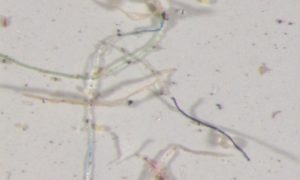
Rainwater samples collected across Colorado and analyzed under a microscope contained a rainbow of plastic fibers. Photograph: USGS
…
by Barbara Jones, August 5, 2017 in MailOnline
- Sky News investigated the Katanga mines and found Dorsen, 8, and Monica, 4
- The pair were working in the vast mines of the Democratic Republic of Congo
- They are two of the 40,000 children working daily in the mines, checking rocks for cobalt
…

Eight-year-old Dorsen is pictured cowering beneath the raised hand of an overseer who warns him not to spill a rock
…
by Christina Lamb, March 21, 2019 in GWPF/SundayTimes
Exploited by Chinese firms, workers as young as nine risk their lives to feed the world’s growing hunger for cobalt.

…
by American Chemical Society, December 5, 2018 in ScienceDaily
New Mexico contains hundreds of historic uranium mines. Although active uranium mining in the state has ceased, rates of cardiovascular and metabolic disease remain high in the population residing close to mines within the Navajo Nation. According to a new study in ACS’ journal Environmental Science & Technology Letters, inhaled uranium in dusts from the mines could be a factor.
by University of Leeds, October 17, 2018 in ScienceDaily
A study by the University of Leeds has examined measurements from more than 1600 locations in China and found that more than 50 per cent of the locations showed a significant decrease in concentrations of sulphur dioxide and fine particulates that make up a large portion of air pollution.
The team used datasets from 2015 to 2017 consisting of hourly assessments of concentrations of Nitrogen Dioxide (NO2), Sulphur Dioxide (SO2), Ozone (O3), and fine particles measuring less than 2.5 μm (PM2.5).
…
by P. Gosselin, September 30, 2018 in NoTricksZone
We have to face it: The West has done our planet no favor by moving industrial production and manufacturing to China. Trump is right, many of factories and industries are better back home, even if it means paying a bit more for products.
Not only does the China use the oceans as a global dump for much of its plastic trash, the country now is gearing up to turn parts of the planet into a toxic solar panel waste dump.
According to French science magazine Futura here, we are looking at a “solar panel time bomb”.
Futura describes how China is installing “gigantic” solar panel farms in remote places like Tibet and how 30 years from now the country will have “mountains of solar panels reaching their end of their lives and that nothing is planned for their collection and recycling.”
…
by Michigan Technological University, August 2, 2018 in ScienceDaily
-
Using 100-year-old minerals processing methods, chemical engineering students have found a solution to a looming 21st-century problem: how to economically recycle lithium ion batteries.
-
Pan, an assistant professor of chemical engineering at Michigan Technological University, earned his graduate degrees in mining engineering. It was his idea to adapt 20th century mining technology to recycle lithium ion batteries, from the small ones in cell phones to the multi-kilowatt models that power electric cars. Pan figured the same technologies used to separate metal from ore could be applied to spent batteries. So he gave his students a crash course in basic minerals processing methods and set them loose in the lab.
…
by Anthony Watts, July 31, 2018 in WUWT
As many WUWT readers know, there’s this push to “save the planet” by banning plastic straws. Like most liberal Earth saving fantasies, it’s rooted in shonky science, or in this case, no science at all, just a guess.
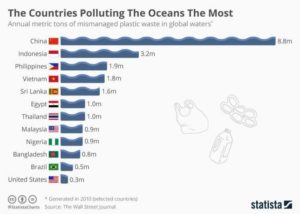
…
by University of the Basque Country, July 19, 2018 in ScienceDaily
A study conducted in mining areas in Asturias by the Animal Ecotoxicity and Biodiversity group led by Dr Pilar Rodriguez, through collaboration between the Department of Zoology and Animal Cellular Biology and that of Genetics, Physical Anthropology and Animal Physiology of the UPV/EHU’s Faculty of Science and Technology, and the Limnology Laboratory at the University of Vigo has enabled progress to be made in this field and has proposed the ecological threshold concentration for 7 metals (cadmium, chromium, copper, mercury, nickel, lead and zinc) and two metalloids (arsenic and selenium). The study included a number of non-contaminated localities belonging to the reference network of the Nalón river basin as well as other highly contaminated ones. This is a basin with a long history of mining activities due to the high levels of metals naturally occurring in its rocks.
by GWPF, June 28, 2018
* Most of the plastic waste comes from just a few countries, mostly in Asia and Africa.
* 25% is “leakage” from Asian waste management processes — the rest is waste that has never been collected, but is simply thrown into rivers.
* But European countries ship inject huge quantities of waste into Asian waste management streams, ostensibly for recycling. As much as 20% — millions of tons every year — ends up in the oceans and will continue to do so.
* Since the Chinese banned waste imports at the start of the year, shipments have been diverted to other Asian countries with even weaker environmental controls (Figure 1).
* EU recycling is therefore a major contributor to marine waste and increasing recycling will therefore simply increase marine litter.
Full paper .pdf here
by Eric Worrall, May 12, 2018 in WUWT
Puna Geothermal Venture has removed 60,000 gallons of flammable Pentane from a geothermal plant in the path of the Hawaii volcanic eruption. But concerns remain that if the geothermal wells break, they could flood the neighbourhood with toxic volcanic gasses.
(…)
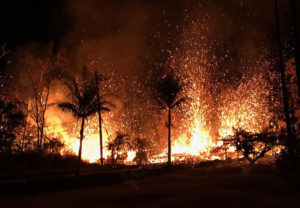
Kilauea eastern rift zone fissure eruption May 2018. By United States Geological Survey [Public domain], via Wikimedia Commons
by B. Friedlander, January 25, 2018 in CornellChronicle
“Plastics make ideal vessels for colonizing microscopic organisms that could trigger disease if they come into contact with corals,” Lamb said. “Plastic items – commonly made of polypropylene, such as bottle caps and toothbrushes – have been shown to become heavily inhabited by bacteria. This is associated with the globally devastating group of coral diseases known as white syndromes.”
When plastic debris meets coral, the authors say, the likelihood of disease increases from 4 to 89 percent – a 20-fold change. The scientists estimate that about 11.1 billion plastic items are entangled on reefs across the Asia-Pacific region, and that this will likely increase 40 percent over the next seven years.
by UNIVERSITY OF YORK and the “blame Russia” department, February 26, 2018 in WUWT
Global levels of ethane and propane in the atmosphere have been underestimated by more than 50%, new research involving scientists at the University of York has revealed.
These hydrocarbons are particularly harmful in large cities where, through chemical reactions with emissions from cars, they form ozone – a greenhouse gas which is a key component of smog and directly linked to increases in mortality.
See also here and here
by E. Krukowska and R. Morison, February 26, 2018 in Bloomberg
European Union nations are poised to endorse the biggest overhaul of the market they created more than a decade ago to rein in pollution, a move that may lift prices of power generated from fossil fuels.
The measures, due for final approval in Brussels on Tuesday, impose tougher requirements on thousands of companies to reduce greenhouse gases or pay higher costs for their carbon dioxide emissions. They’re part of a plan to clear up a flaw in the market that left the cost of CO2 permits well below the level needed to stir investments in green energy.
by Edouard Guigue, 13 janvier 2018
Que sont les métaux rares ? Des ressources peu connues mais essentielles au fonctionnement de l’espace mondialisé. Insérées au cœur de tout appareil électronique, sans elles aucune de nos technologies numériques n’existerait. Composant également la plupart de nos technologies vertes (éoliennes, panneaux solaires ou voitures électriques), leurs modes de production laissent toutefois perplexe sur leur capacité à s’établir comme alternatives durables aux énergies fossiles. La pollution ne serait pas réduite mais simplement délocalisée… essentiellement en Chine où 95% des terres rares sont produites. Un chiffre qui par ailleurs devrait nous alarmer sur la situation de dépendance à la Chine dans laquelle le reste du monde -dont l’Europe- se trouve depuis les années 1980. Guillaume Pitron nous présente une enquête de six ans, dont les résultats sont à retrouver dans son livre La guerre des métaux rares.
La géologie, une science plus que passionnante … et diverse







